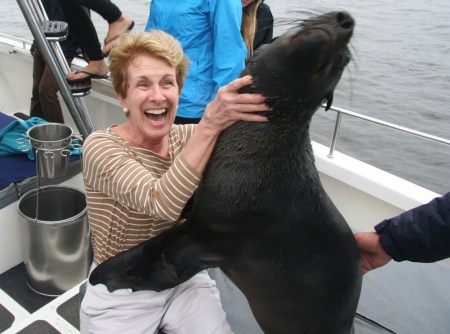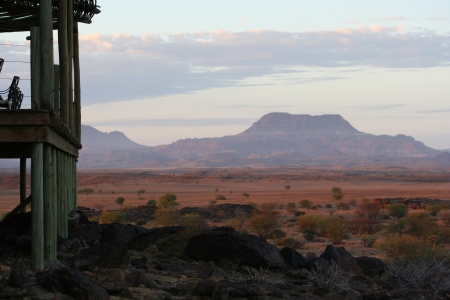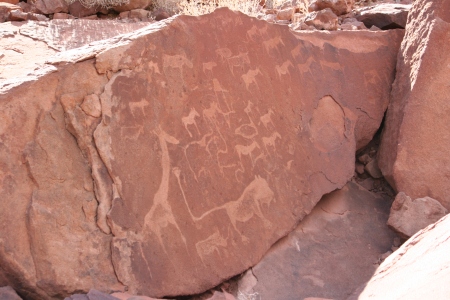It was our penultimate day in the country and we were out for a morning drive. We were moving at a leisurely pace in our open Range Rover along a straight and narrow forested road, admiring the abundant bird life, when all of a sudden there was a great crashing noise to the left. I turned to see an adult Black Rhino charging full tilt out of the forest and right at us (seemingly right at me since I was on the left side of the vehicle)! It slammed to a halt about 10 feet away, glared at us, lowered and shook its head, made a huge snort and then…
One of the great enjoyments of my retirement is having the opportunity to travel to other countries and learn about their history, culture, geography, art, architecture, food, beverages, languages, government, social customs and the like.
Recently, my wife and I, along with some friends old and new, were able to visit one of the youngest countries in the world: Namibia. It is located on the southwest coast of Africa, north of South Africa, south of Angola and west of Zambia and Botswana. In size, it is twice the land mass of California but only has a population a bit over 2 million making it one of the least densely populated nations in the world. Its official language is English although about 60% of the population speaks Afrikaans and 30% speak German. There are also a number of tribal languages and many Namibians are multilingual. It has a democratic government and gained its independence from South Africa in 1990. The most important sectors of its economy are mining, fishing, agriculture and tourism.
Namibia is a very dry country. It gets little rain and has almost no surface water. It is home to two of the world’s great deserts: the Namib along almost its entire coastline in the west, and the Kalahari which makes up most of the eastern part of the country. The coast is called the “skeleton coast” due the large number of bleached whale and seal bones along the shore from when they were aggressively hunted, as well as for the large number of shipwrecks that have occurred there since the Portuguese began seeking a way around Africa to get to India and the Spice Islands.
The original people of Namibia were the nomadic San who were gradually replaced by the tribal Khoi-Khoi who were herders. Both the San and Khoi-Khoi were supplanted by the Bantu beginning about 2,400 years ago. In the late 19th century Germany, looking for land in which to expand, annexed Nambia and began taking over the best land for farming, driving the native population into the desert in the process. In 1904, a rebellion by the Herero people was brutally smashed with over 60,000 of them being killed. Following WWI, South Africa was given a mandate by the League of Nations to rule the Namibian territory, but the treatment of the native Namibians was not much better than under the Germans. The United Nations eventually voted to end South Africa’s mandate and, after much regional strife, Nambia finally became independent in 1990.
The capital of Namibia, Windhoek, reflects its heritage as a Germany colony both in architecture and cuisine (beer and sausage). The 500 seat church pictured below – Christuskirche – was built in part to symbolize triumph over the native culture:
The Sossusvlei region of the Namib desert has the world’s tallest sand dunes, some of them towering 1,000 feet above the desert floor. They are red-orange due a high level of iron oxide. They are best seen early in the morning when early light plays against the sand. If you are feeling strong you can climb them:
From Swakopmund on the coast it is easy to visit the Skeleton Coast and see shipwrecks and wildlife:
After a day on the water it can be fun to visit a local tavern for some beer, fried caterpillars and chat with the locals:
In Damaraland we learned how to track elephants (in part, by analyzing their dung). We were successful in finding several herds of “desert-adapted” elephants, which have smaller bodies and longer legs than the savannah/forest African elephants, and can go for several days without water:
Our campsite in Damaraland was reminiscent of the Grand Canyon:
In Twyfelontain we saw 2,500 year old rock carvings depicting African wildlife. These are considered among the best prehistoric art on the continent. There are over 2,500 individual carvings. Some examples:
Each sunset called for a “sundowner” beverage to toast the magnificence of the landscape:
Our final stop was Etosha National Park in the north of the country. It is roughly the size of Switzerland and is the third largest animal sanctuary in the world. We saw lions, springboks, wildebeests, zebras, giraffes, jackals, kudu, ostrich, a wide variety of birds and of course, rhinos. A few examples below and then back to the charging rhino with which I began:
I turned to see an adult Black Rhino charging full tilt out of the forest and right at us (seemingly right at me since I was on the left side of the vehicle)! It slammed to a halt about 10 feet away, glared at us, lowered and shook its head, made a huge snort and then…
and then it quickly made a 90 degree turn to the left and charged off into the forest.
When the Rhino had charged there had been a collective gasp in the vehicle. Now there was total silence. Then our Namibian Tour Leader made a loud snorting imitation of the Rhino, we all laughed with nervous relief and then we moved on down the road.
R. Kevin Price
www.successfulretirementguide.com
© 2008-2013 R.K. Price















I have stood on Dune 7 at Walvisbaai, it was HARD work getting there!